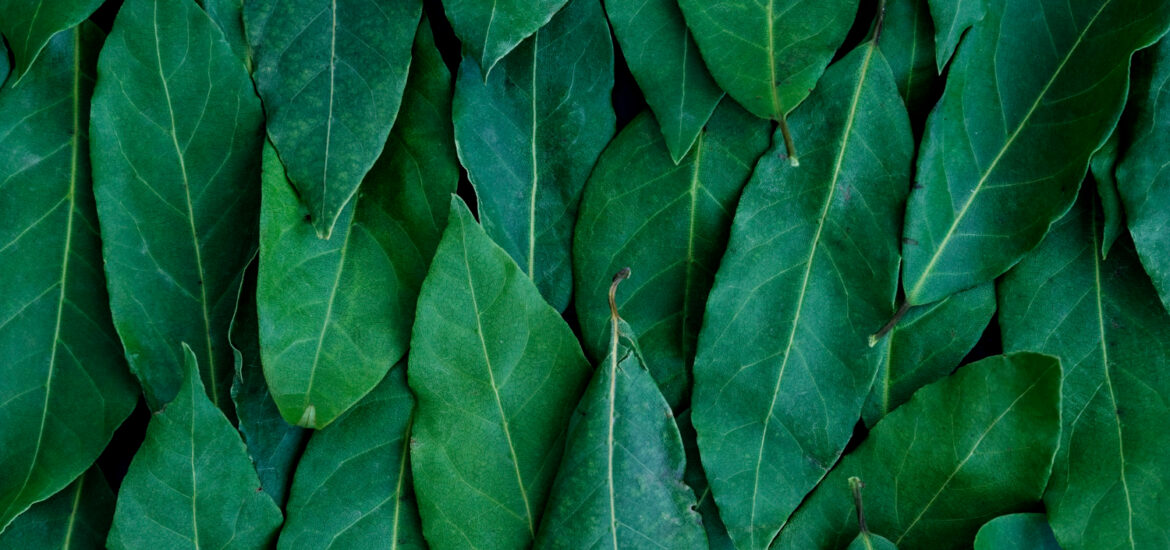In Peru’s Andean areas, such as Cusco, Arequipa, and other regions, an ancient remedy for altitude sickness has gained recognition—the coca leaf. Known for its effectiveness in alleviating high-altitude symptoms, the coca leaf boasts several beneficial properties that extend beyond just remedying altitude-related discomfort.
You may be surprised to learn that the coca leaf is not only consumed as tea. In traditional markets across Peru, such as the lively San Pedro Market in Cusco, you’ll find coca leaves and various derivatives available for purchase.
At this point, you might be wondering about the perception of coca in Peru. While it’s true that coca is the main component of cocaine, it’s essential to understand that Peru does not promote illegal activities. The coca leaf has a profound historical and cultural significance in Peru, deeply rooted in the traditions of its people.
Let’s explore the importance of the coca leaf for our culture, its role in the daily lives of many Peruvians, and even its health benefits. Understanding this ancient bond with the coca leaf will provide a clearer perspective on its value in Peruvian society.
History and Cultural Significance
Coca leaves are a cherished part of Andean culture, with a rich history that spans thousands of years. Archaeologists have found these leaves in ancient tombs, highlighting their significance in both everyday life and in beliefs regarding the afterlife. During the Inca Empire, coca was more than just a plant; it was a symbol of connection to nature and the divine.
It played an important role in religious rituals that honored “The Pachamama”, mother Earth, and The Inti, the sun deity in Inca Mythology. People used to offer coca leaves to express their gratitude for good harvests and to seek protection in times of conflict. They also believed these leaves could give strength and clarity to warriors preparing for battle.
The Spanish conquest in the 16th century didn’t affect Coca’s importance, in fact, indigenous workers who chewed coca leaves showed remarkable strength in tough mining environments, powering laborers against fatigue with the support of Spanish missionaries. We can see the rich history of coca chewing through the ancient coca leaves found at the Huaca Prieta settlement, dating back to 2500 BC,
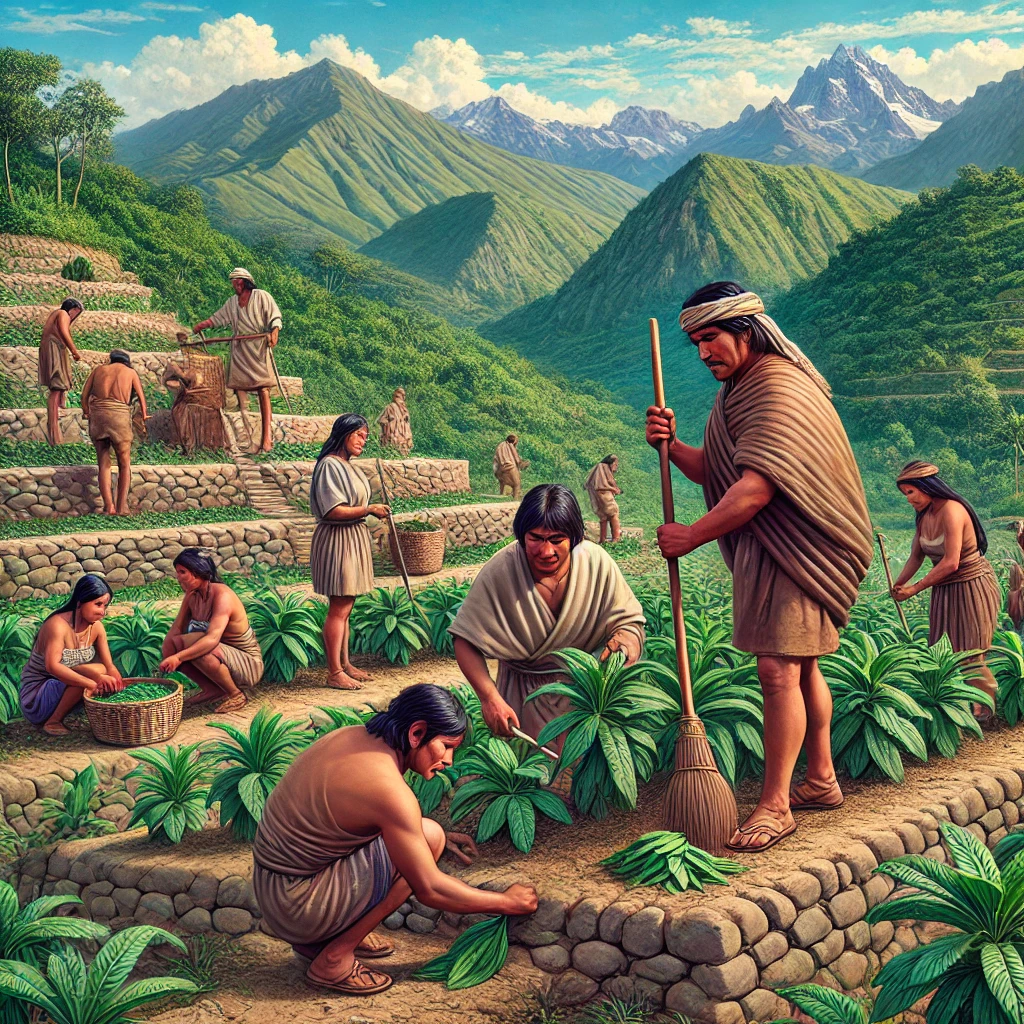
Aymara legends beautifully describe the coca plant as a divine gift, helping people endure challenging conditions. The Incas revered coca as a divine gift from the sun god Inti and the moon goddess Mama Quilla. It was believed that Manco Capac, the Incan demigod, introduced the coca plant to aid the people.
During the reign of Inca Topa Yupanqui, the cultivation of coca was restricted to the elite. Kuka Mama, a goddess of health and joy, is also associated with coca in Peruvian folklore. More than 500 years later, in 1940, a decree made coca mandatory in mining and railroad towns, recognizing its essential role. Today, coca’s spiritual significance persists.
Coca leaves remain vital in rituals, conveying gratitude, offering blessings, and strengthening community bonds. Farming communities gather to share coca, honoring their ancestors and Mother Earth by burying leaves in the ground before work, acknowledging the gift of coca. Coca-infused rituals celebrate significant life events, solidifying its profound cultural impact on Andean society.
The Coca Leaf and the altitude sickness
“Mate de coca” is the beloved herbal tea made from coca leaves. It has a flavor similar to green tea, with a little bitterness and a hint of sweetness. Many people appreciate its health benefits, like boosting energy, easing headaches, reducing fatigue, quenching thirst, and even helping to prevent altitude sickness.
When travelers arrive at their hotels, they often receive a warm cup of coca tea as a friendly welcome. Some women also chew coca leaves during childbirth to help speed up labor and relieve discomfort. Coca leaves have been an important part of community life for many years, and their traditional use continues to be a cherished part of Peru’s cultural identity.
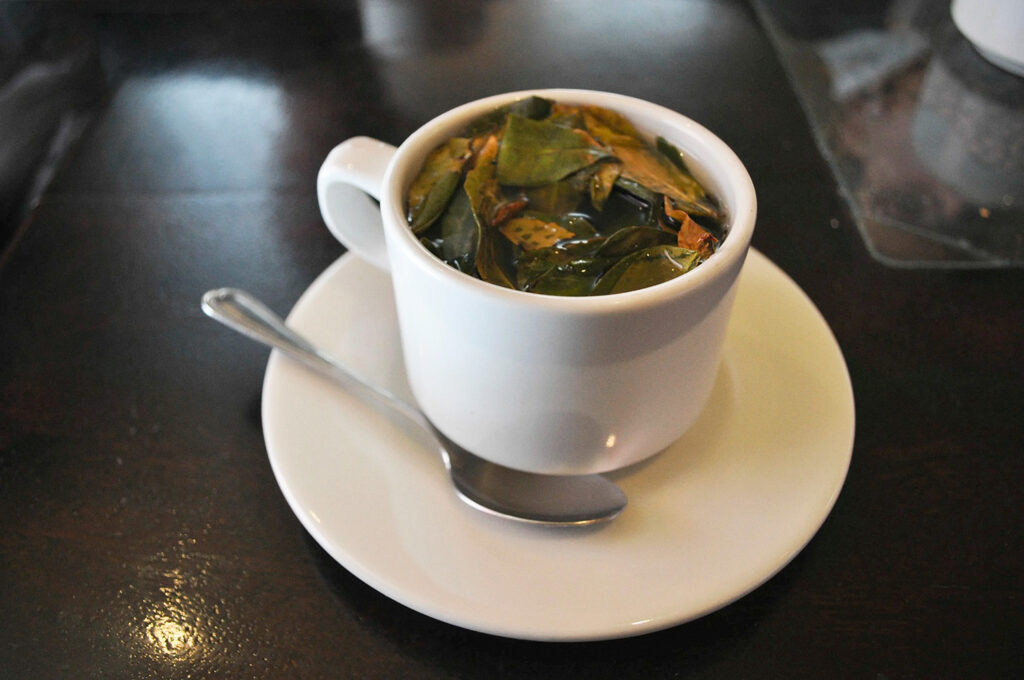
In the Andes, locals often turn to coca leaves to help with mild altitude sickness, as many workers rely on them to feel better at high elevations. It’s important to mention that coca leaves contain alkaloids, which can be turned into cocaine. However, the amount of raw leaves is very small and not addictive.
A cup of coca tea made from one gram of leaves contains about 4.2 mg of organic coca alkaloids, providing an energy boost like coffee or tea. This makes it especially beneficial for those exploring the stunning landscapes and sights of Peru.
More benefits
Vitamins and Minerals
Coca leaves are a natural source of vitamins A, B1, B2, B3, C, and E, and contain essential minerals such as calcium, iron, sodium, potassium, and phosphorus.
Alkaloids and Tannins
They contain 14 alkaloids and various tannins, which help alkalize the body, contributing to overall health.
Oxygenation and Circulatory Health
Consuming coca leaves stimulates oxygenation, enhancing the respiratory and nervous systems, improving the oxygenation of the brain and blood, and helping regulate blood pressure.
Combats Anemia
Coca leaves combat iron-deficiency anemia, thanks to their high iron content.
Digestive Health
They aid in digestion, helping to expel gas, strengthen the intestinal flora, and regulate carbohydrate metabolism, making them beneficial for people with difficulty digesting sugars.
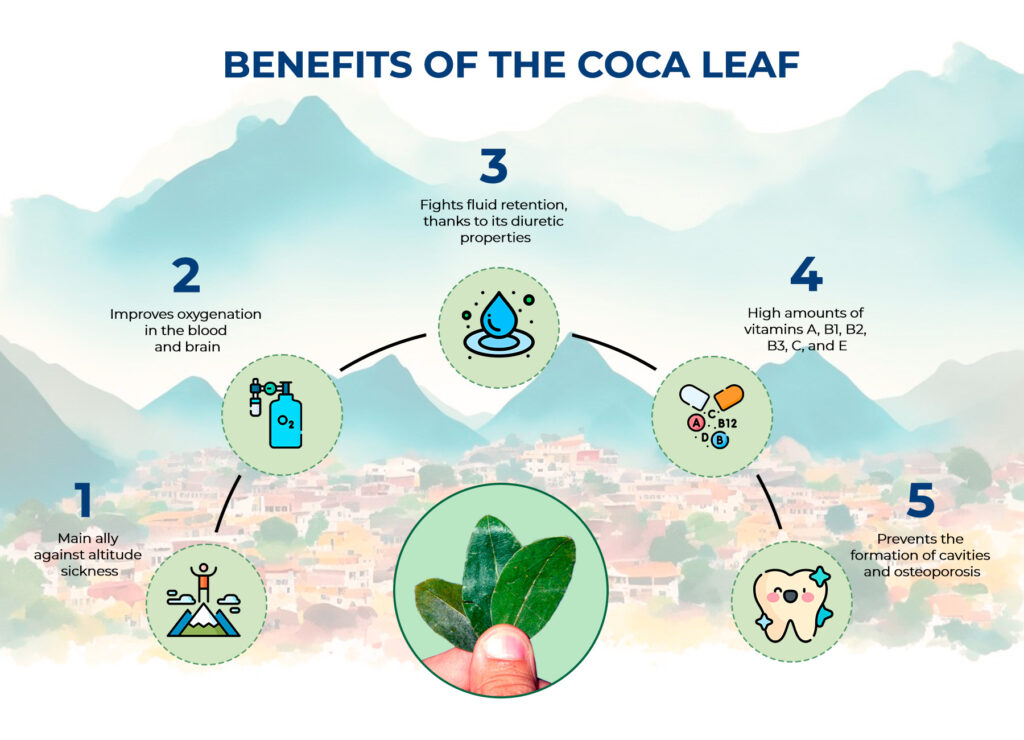
Pain Relief
Due to their analgesic properties, coca leaves can help relieve pain caused by arthritis or rheumatism.
Mental Clarity and Focus
Coca leaves improve memory, concentration, and attention by stimulating the nervous system through enhanced oxygenation.
Physical Endurance
Improved oxygenation allows the body to function better overall, increasing physical endurance and stamina.
Appetite Regulation
They regulate appetite, which can be beneficial in treating eating disorders.
Antioxidants and Immunity
The vitamins in coca leaves have antioxidant properties, strengthening the immune system.
Dental and Bone Health
Finally, coca leaves help prevent cavities and osteoporosis due to their high calcium content.
Chewing and other uses
As mentioned earlier, following the Spanish conquest, the use of coca leaves grew significantly, particularly among indigenous workers who found them invaluable for enduring long hours of labor. Chewing dried coca leaves with an alkaline substance, such as quicklime, is a traditional practice known as “chacchar” in Peru.
This custom has been performed in Andean countries, including Peru, for approximately 8,000 years. The ritual of chewing coca leaves not only alleviates hunger and fatigue but also fosters a sense of community, strengthening social ties among Andean people. By chewing coca, consumers gradually absorb the alkaloids, which prolongs the effects of the leaves.
This practice is a cherished social custom that reflects the rich heritage of the Andean culture and the generations who have enjoyed its benefits. The use of coca leaves in the Andean culture goes far from only beneficial properties, it also it’s a way to express indigenous peoples’ ancient beliefs. For example, coca leaves hold a special place in rituals that express gratitude for nature.
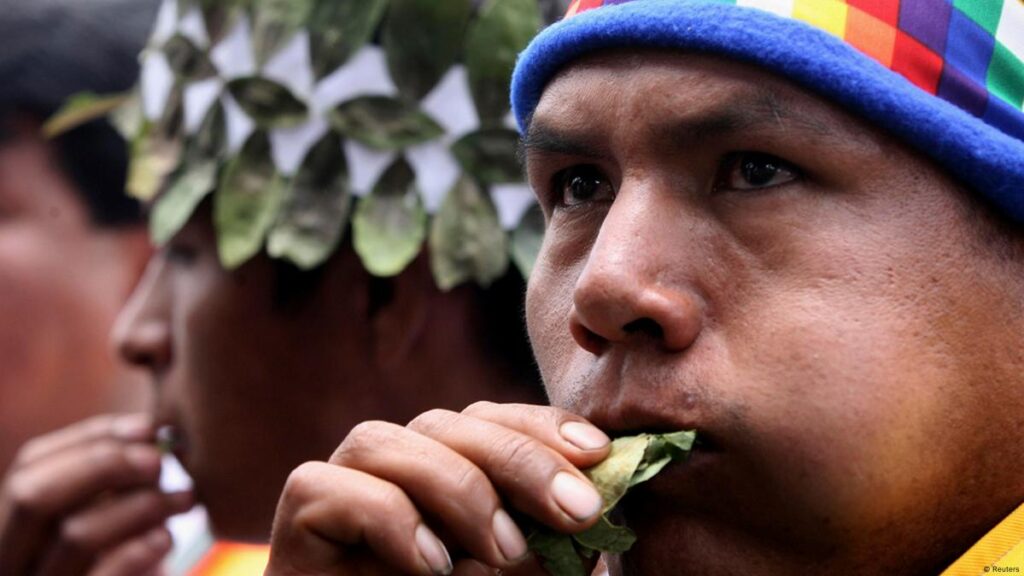
One popular ritual is called Ch’alla, where people offer coca leaves to Pachamama as a way to show respect and gratitude. During significant events, like the start of a harvest or the building of a new home, it is common to scatter coca leaves on the ground as a meaningful offering.
Coca also plays an important role in divination. In this practice, a shaman, known as “paqo”, a practice that involves interpreting coca leaves placed on a cloth to provide insights about the future or to answer important questions. This sacred act of divination is reserved for those who have a deep understanding of coca and the Andean way of life, making it a cherished tradition within the community.
As you can see, the coca leaf is much more than just a simple plant; it is an ancient and millennia-old asset that plays an integral role in our rich culture. Unfortunately, its reputation may be viewed negatively in some countries. However, now that you understand the truth about these leaves and their traditional use, you can appreciate their cultural significance. When you’re in Peru, don’t miss the opportunity to try coca tea.
Take a moment to reflect on its importance and the benefits it offers not only to the Andean people but also to you, thanks to its numerous health properties. Embracing this aspect of Peruvian culture will enhance your experience and understanding of this remarkable plant.
To know more about our country, and its vast culture travel with Viagens Machu Picchu. Leave all the stress of setting up a trip behind, and leave it all to us! We’re experts in designing dreams for our beloved customers. Contact our specialists to start living the Peruvian dream!
Viagens Machu Picchu, journeys that inspire, moments that last.
| Español > Viagens Machu Picchu |
| English >Viagens Machu Picchu |
| Portugués > Viagens Machu Picchu |

